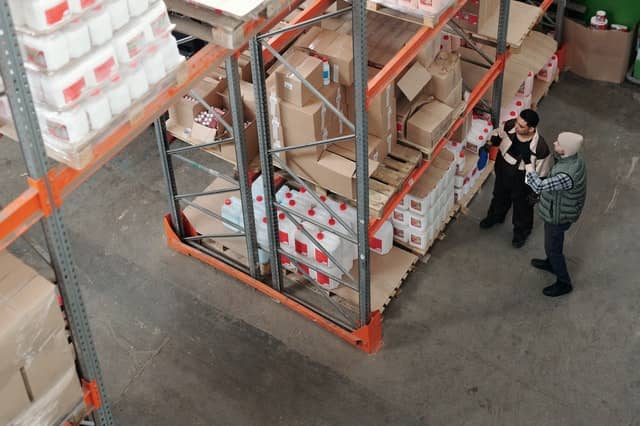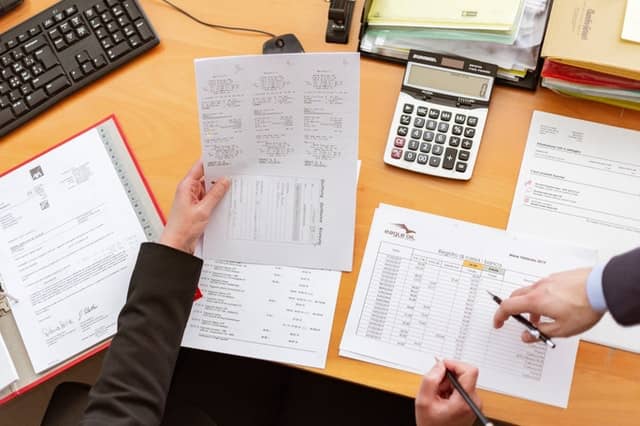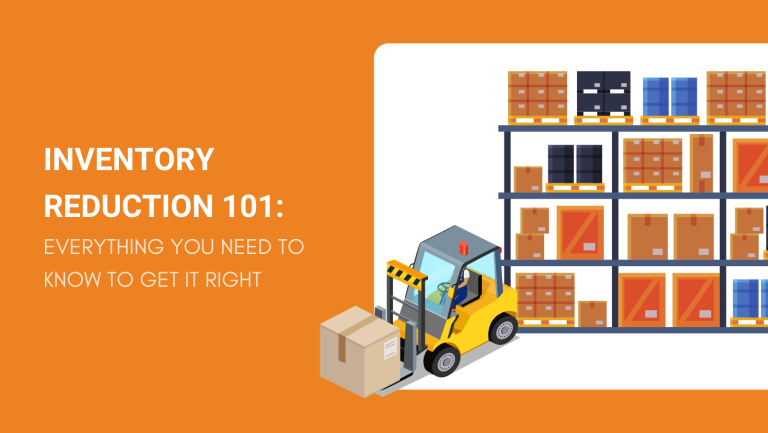Adequate inventory level is essential to the supply chain of every business. It makes it possible for you to keep up with customers’ orders and should tide you over until the next delivery from your supplier.
In contrast, too much inventory can weigh heavily on a business. It can get expensive to manage and may even require more storage space than you have in your facilities.
So, in today’s blog, we shine a light on all things inventory reduction. We discuss when and how to do it as well as its importance and how it could improve your business.
Read on.

What Is Inventory Reduction?
Inventory reduction is a process that entails minimizing the amount of stock that your business holds to levels that:
- Match customer demand
- Are cost-effective to manage
For example, if you have been ordering 1,000 units of a product per month but only sell 400 units, you would have a surplus of 600 units every month.
It would, therefore, be wise to reduce your inventory to stop accumulating and maintaining more product units than you are selling.
Why Is Inventory Reduction Important? Benefits of Inventory Reduction
Reducing your inventory levels can, at first impression, seem like a wrong move. Most entrepreneurs prefer to hold some extra stock because:
- Customer demand is hardly ever constant and extra inventory helps to accommodate shifts in demand.
- Extra inventory can help keep your business steady when faced with supplier delays or product shortages.
However, reducing inventory is not about preventing you from having contingencies. Rather, it cuts back surplus stock that causes inefficiencies. This comes with benefits such as:
Reduced Costs

The more inventory you have, the more you are likely to spend on labor and storage space to manage it. Subsequently, scaling down your inventory levels would naturally reduce your inventory management costs.
Improved Warehouse Management
Even with automation, a vast amount of stock can be difficult and time-consuming to manage. It may:
- Increase the likelihood of errors in inventory management.
- Increase the amount of time it takes to process orders.
- Cause disorganization if there is not enough room to properly store the inventory.
In comparison, lower amounts of stock can be easier to manage and would allow your warehouse to run more efficiently.
Less Wastage

When you have more products in stock than you are selling, their expiry dates can come due while they are still in your warehouse.
If this happens, you may have to dispose of them and take the loss, which is wasteful. Alternatively, you may have to sell everything off in a hurry and at discounted rates. You can also suffer losses through pilferage or incidental damage in the warehouse.
All these high-pressure and low-reward solutions can be avoided by reducing your inventory early enough through proper channels.
Better Business Flexibility
Reducing product stock frees up your funds, storage space, and other business resources. It allows you to explore other better-selling products in your niche if you wish to or even develop private label products. It is much better than being chained to dead stock.
Potential Cost Savings from Inventory Reduction

Inventory reduction can save your business money in 3 major ways:
Lower Inventory Management Costs
Optimal levels of inventory will cost you less in terms of labor, transportation, insurance, and storage space.
Prevention of Losses
Strategically lowering your stock levels can help your business avoid losses that arise from:
- Products going bad or becoming obsolete while in storage
- Theft
- Inadvertent damage
- A decline in product prices that eats into your profit margins
Avoiding the Cost of Credit
Holding more stock than the level of customer demand often means that:
- Your sales and profits are lower than anticipated
- Most of your business capital is held up in the stock
As a result, you may experience cash flow issues and have to seek credit to meet the financial obligations of your business.
Meanwhile, reducing your inventory could free up your capital and save you from having to take up any loans and incurring the cost of credit.
Inventory Reduction Formula

Arbitrary inventory reduction can cause financial losses or result in inventory levels that are still not optimal for your business.
The inventory reduction formula can be used as a guideline to help businesses get the process right. The formula is based on a factor known as the Economic Order Quantity (EOQ).
EOQ is the optimal quantity of a product that a company should order to minimize its inventory management costs. In other words, if the EOQ of your business is 700 and you order that amount, your business is likely to incur lower inventory ordering or holding fees.
The formula for calculating EOQ is as follows:
EOQ = √ (2 x Demand x Order Cost / Holding Cost)
How to Reduce Inventory
There are multiple ways to reduce inventory. The best approach is to weigh each option and decide which of them can aptly address the challenges your business is facing. Let’s discuss the top options.
Find a Reliable Supplier

You may be prone to ordering and holding more inventory than necessary to avoid shortages when your supplier fails to deliver on time.
Of course, no supplier is perfect and delays in the supply chain are expected from time to time. However, if your supplier is not dependable and causes you to stockpile, it may be best to consider partnering with a different supplier.
Regular supply allows you to order just enough because you are not worried that restocking will be a challenge.
Use the ABC Approach
The ABC approach involves prioritizing the goods in your inventory by placing them in categories.
Group A should comprise products that have a high sell-through rate and bring in good profits. Group B should consist of average-performing products while Group C would include the lower-ranking goods in terms of sales and profits.
Sorting your inventory this way gives you a clear picture of which products matter most to your business. Subsequently, you can reduce the goods in groups B and C by selling off what you have and ordering less of them going forward.
This method also helps you free up capital and other resources which you can redirect to the high-selling goods.
Hold Discounted Sales

Incentives like discounts and other sale offers encourage customers to buy goods that they may have previously been reluctant to buy. They would, therefore, be a great way to get rid of some of the stock that you have.
Be sure to advertise your sale offers diligently so that you can draw more buyers.
Offer Product Bundles
Sometimes even when a product is discounted, customers may still not be keen to buy it. Nevertheless, you still need to get the stock of the undesired items off your hands. So, why not create product bundles?
Each product bundle would comprise a product that consumers like and those that are perhaps less popular. To make it even more appealing, offer the bundle at a discounted price.
At the end of the day, it is a win-win for all. Customers get more value at a bargain and you get to sell off your stock.
Negotiate Flexible Ordering
A flexible ordering arrangement means that you can order different product quantities when you restock instead of a fixed regular quantity.
Negotiating this kind of arrangement with your supplier allows you to adjust your order based on demand forecasting or how much inventory you have sold since the last restock.
In turn, you can sell and reduce the stock you have before ordering more. It is more manageable than just ordering a constant quantity of inventory that may only fill up your premises.
Use Demand Forecasting

Demand forecasting involves using research and data to understand:
- The products that customers are interested in
- How many units of those products you may need to satisfy the demand
This approach helps you reduce inventory by guiding your restock orders. It shows you what your customers need so that you can avoid having dead stock.
Avoid using sales as your only key metric for demand forecasting. Consumers’ interests change with time. They may be crazy about linen shirts one summer and obsessed with printed t-shirts by the next and your business needs to keep up.
How to Reduce Inventory Carrying Costs
Inventory carrying costs are also known as holding costs. They are the expenses that a business incurs for the period when goods are stored in its warehouse. The costs include:
- Storage fees
- Labor
- Transport
- Insurance
- Taxes
Beyond these standard expenses, businesses may also incur other inadvertent carrying costs.
- Depreciation – if the costs of the commodities decline while they are in stock, you may have to sell them at a lower price than anticipated.
- Shrinkage – you may end up selling a lower number of products than you initially had due to theft, damage during storage, or warehouse management errors.
- Opportunity cost – you may have to miss out on more lucrative product lines or other opportunities because your capital is tied up in the inventory or due to a lack of space in your warehouse.
While these costs are often unavoidable, it is best to always keep them as low as possible. Here are some tips you can use to achieve that.
Automate Your Inventory Management Systems

Automating your warehouse would:
- Make it possible to run the warehouse with a leaner workforce and cut back on your labor expenses.
- Enable you to get more accurate and up-to-date inventory data to curb inventory shrinkage.
- Reduce your handling costs.
- Enable you to handle more orders and increase sales because the use of machines would reduce order processing times.
Each of these benefits helps boost the efficiency of your inventory management thereby reducing the expenses you incur.
Speed Up Inventory Turnover
The longer you have to hold inventory, the more expenses you are likely to incur. So, strive to reduce the duration between when you receive stock and when it leaves your warehouse.
One way to do this would be to offer wholesale discounts. It would encourage customers to buy in bulk and relieve you of your inventory within a shorter period.
Maintain Optimal Stock Levels
High stock levels cost more to hold. In contrast, overly low stock levels may also leave your warehouse resources idle which means it will be running at an inefficiency.
Identify the optimal stock levels for your business and try to stick to them. They promote efficiency and will help you keep your carrying costs at a manageable percentage.
Improve the Layout of Your Warehouse

A poorly planned warehouse complicates inventory handling procedures, makes it difficult to organize or locate inventory, and generally promotes inefficiency. Optimizing the warehouse layout to support efficiency and drive down your costs.
Find the Right Reorder Point
Once you automate your warehouse, it will be easy to keep track of supply deliveries and product turnover. Observe the trends for a while and use that data to identify an ideal reorder point.
How to Improve Inventory Turnover

As we have discussed above, inventory turnover refers to how quickly product stocks leave your warehouse after you restock. A high turnover is better because it minimizes your carrying costs and also shows that your business is running optimally.
So, how do you improve inventory turnover in your warehouse?
Focus on the Right Products
Be wary of seasonal products or products with low demand. If you have to stock them, do so in small quantities. Focus instead on products that customers are interested in and are willing to buy.
Incentivize Buyers
Consider offering your customers incentives that encourage them to keep buying from you. Such incentives could include:
- Free shipping
- Wholesale discounts
- Discounted prices
- Coupons
- Gift samples upon buying certain products or meeting set MOQs
Stellar Customer Service

Outstanding customer service creates a good reputation for your business, makes customers feel valued, and builds customer loyalty. It increases the chances of customers coming back to buy more or recommending your business to other buyers.
Keep Things Interesting
Shoppers may be dedicated to specific products but most also enjoy exposure to new trendy products. As such, it is a good idea to revamp your product catalog regularly and let customers know about the new items you have to offer.
Regular changes also inspire urgency among customers. It prompts them to buy their favorite items before they are replaced with newer options.
What Is Just-In-Time Inventory?

Just-in-time (JIT) inventory is a measured supply of products or raw materials delivered right when it is required.
For example, if your inventory records indicate that Product X will be out of stock in about 2 weeks, you can liaise with your supplier to have it delivered a few days before that deadline.
The aim is to avoid ordering raw materials or ready-to-sell products way ahead of time only to have them sitting in your warehouse for months and driving up your holding costs.
Further, JIT inventory orders are made relatively close to the delivery date. As a result, you can order a more suitable quantity of products based on the current demand trends.
This curbs wastage unlike situations where you order stock in advance, hold it, and then suffer the consequences of fluctuating demand.
Best Practices for Inventory Reduction

So far, we have covered all the key aspects of inventory reduction and you are likely ready to take it on like a pro. However, before you get started, here are some highly recommended practices to always keep in mind.
Use Data-Based Approaches
Using data will help you make informed decisions about:
- How much inventory to offload
- The products to target during the reduction
- The right safety stock levels for your business
- The right reorder points
It makes the entire process more systematic and effective than simply making choices on unverifiable observations.
Understand Your Market
Research, observe and learn the traits and preferences of your customers. This will help you make more accurate demand predictions. It may equally come in handy when deciding which inventory reduction method to use.
Consult Your Suppliers
Any inventory adjustments you may need to make during inventory reduction will require the cooperation of your suppliers. It is thus prudent to discuss your decisions with them and negotiate so that you can reach an agreement that works for all parties.
Carry Out Regular Reviews

It is advisable to regularly review the performance of your business to determine whether you need to carry out inventory reductions.
Detecting challenges proactively leaves more room to address them as opposed to finding out when the situation is already out of hand.
FAQs about Inventory Reduction
What Situations Bring about Inventory Reduction?
Inventory reductions can become a necessity when:
- Storage space runs low – this calls for inventory reduction because it indicates that a business is likely holding more stock than it should, has low turnover, or is ordering too many units.
- Holding costs are too high – this often happens when a business is carrying more inventory than is profitable.
- Cash flows run low – low inventory turnover leads to strained cash flows because the business is spending more than it is making.
- The inventory becomes obsolete – if expiry dates come due or the products are no longer viable in the market then there is no option but to get rid of them.
What Are the Disadvantages of Reducing Inventory?
Reducing inventory comes with lots of benefits but it can present some downsides too. They include:
- Financial losses – reducing inventory can involve selling products at throw-away prices which can result in losses.
- Increased dependency on suppliers – leaner safety stocks leave you more dependent on your supplier because you will be unable to meet customer demand for too long if new stock is delayed.
- Higher restocking costs – ordering smaller batches of inventory can result in higher costs due to frequent shipping, lower bulk discounts, and other logistical expenses.
In Conclusion
Inventory reduction can be a new dawn for your business. It enables you to achieve better profitability and pursue new opportunities, and make your venture much easier to run.
We can help you find manufacturers that can accommodate your supply requirements and also coordinate worldwide shipping so that you receive your inventory right on time.
Ready to get started? Send us an outline of your product sourcing needs, request a free quote, and we will promptly get back to you with suitable solutions.

